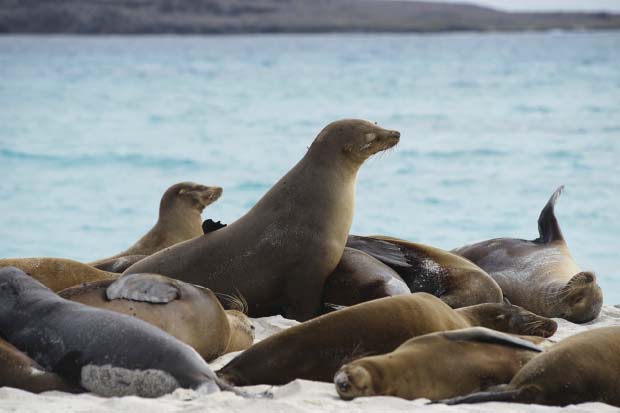‘Think dogs in wetsuits,’ said our guide of the cluster of sea lions at our feet on San Cristobal, one of the remote collection of 19 volcanic Pacific islands slap bang on the Equator that make up the Galapagos. Struggling awkwardly up black lava rocks or even there along the sands of Cerro Brujo, the most beautiful beach I have ever seen, the 31-stone beachmaster and his harem looked ungainly, even ridiculous. But when they join you as you snorkel amid brilliantly striped and spotted technicolour fish in every shape and size, you can only marvel at the sea lions’ power, elegance and playfulness as they barrel-roll alongside you and accelerate effortlessly away in their natural element.
Like the turtles paddling serenely below, or the hammerhead and white-tip sharks we novices eyed a little more edgily in the deeper water, they were just one of the treats to be enjoyed in the most compelling wildlife destination on Earth.
Penguins in the tropics, cormorants that cannot fly, giant tortoises that can weigh up to 550lb and live for 150 years, and giant lizards that have learned to dive into the sea for food: the Galapagos really does have the most fascinating collection of animals on Earth, most of them impossible to see anywhere else, like the waved albatrosses which breed only on Espanola Island.
The famous finches, the birds whose differing beak sizes in different terrains inspired Darwin’s theory of natural selection, are mostly a drab grey or unexciting black, but the vivid colours of many other Galapagos residents compensate. You can watch blue-footed and red-footed boobies engaging in endearing mating rituals, and little yellow warblers silhouetted against the black lava. The sizeable Sally Lightfoot crabs scuttling across the rocks come in shades of bright orange and electric blue. Even the prehistoric-looking land and sea iguanas come in varying shades of yellow, green and pink according to which island you have landed upon. The joy of it is that most of these creatures have little or no fear of humans. Under the rules, you may not go closer than two metres to the local wildlife, but the birds and beasts have not read the regulations and will often come closer than that of their own accord, a mockingbird perching on your backpack looking for water, or a sea-lion pup clambering across your shoes in a search for shade.
The landscapes, too, vary from island to island. The damp green highlands on Santa Cruz give giant tortoises a home, while the pillow lava of South Plaza offers little more than cactus plants on the way to cliffs where tropic birds and swallowtail gulls nest, while piratically swooping frigate birds stage mid-air attacks on shearwaters and boobies, grabbing wings or tails to scare them into dropping their catch. Even an animal-free island like Santiago, formed by an 1895 eruption, was fascinating: the variety of patterns formed by the onrushing hot lava were like a huge 3D kaleidoscope fixed in rock. Think hundreds of crazy cake-mixes, think tangles of fraying rope-ends, think Indian temple art and Henry Moore in miniature.
The only practical way of visiting the Galapagos is aboard live-in boats after a flight from the mainland of Ecuador, 600 miles away. The national park authorities control things tightly. Only designated sites may be visited; you may land only at specified spots; you must keep to clearly defined trails and be accompanied always by a certified guide. It has to be like that: Ecuador needs tourist spending to aid projects designed to preserve the wildlife, and to make up for man’s past depredations: breeds of bird, tortoise and iguana have already been wiped out by the rats, goats and pigs we introduced to the islands. But the arrival of 180,000 tourists a year to add to a local population that has ballooned from 25,000 in the 1960s to 250,000 today brings its own problems: in an ecosystem so unique, the introduction of one new plant or animal species can create havoc.
Much of your life as a -Galapagos visitor will be spent in pangas, the motorised dinghies which ferry you from ship to ‘dry’ or ‘wet’ (that means wading ashore through the shallows) landings on islands for your land expeditions, or which act as a diving base for snorkelling expeditions. Because the park authorities prescribe the permitted landings for each vessel, your boat will be charging on from one island to another as you sleep (or try to), and the schedules mean that on one trip you won’t see everything. The islands chosen for us meant that we had only a cursory glimpse of the Galapagos penguins and didn’t see the flightless cormorants at all. We did see the albatrosses though; we watched flamingoes feeding in a saline lake and we stood in beach shallows watching stingrays swishing around our feet, taught how to avoid trouble by our knowledgeable guide, Darwin, who switched effortlessly from discussions of tectonic plates to sea snakes, Pacific currents and where the sexual organs of giant tortoises are located.
The schedules are vigorous: it is 90 per cent paradise and 10 per cent bootcamp. But you will never be bored and I have one word of advice if you do choose to go: don’t head straight home from the Galapagos but add some time in Ecuador itself, a country eagerly extending its tourist industry and still seemingly enjoying the process. I will never forget the giant condors I saw soaring in the air currents amid the snow-capped volcanoes near Quito, nor the 140-plus birds seen in three days at Sacha Lodge, a tourist haven carved heroically out of the rainforest an hour or so down an Amazon tributary from Coca. But that is all part of another story…
Got something to add? Join the discussion and comment below.
Get 10 issues for just $10
Subscribe to The Spectator Australia today for the next 10 magazine issues, plus full online access, for just $10.
You might disagree with half of it, but you’ll enjoy reading all of it. Try your first month for free, then just $2 a week for the remainder of your first year.















Comments
Don't miss out
Join the conversation with other Spectator Australia readers. Subscribe to leave a comment.
SUBSCRIBEAlready a subscriber? Log in